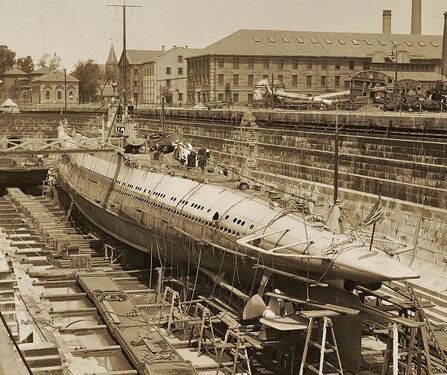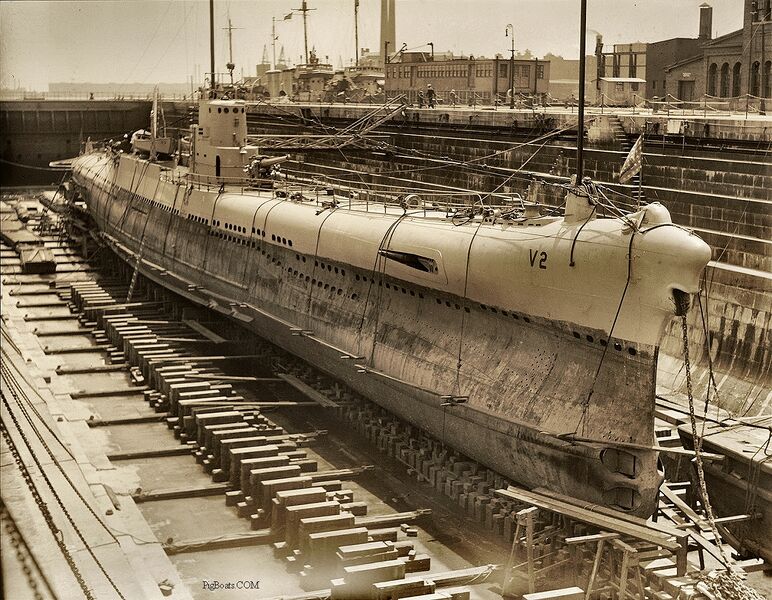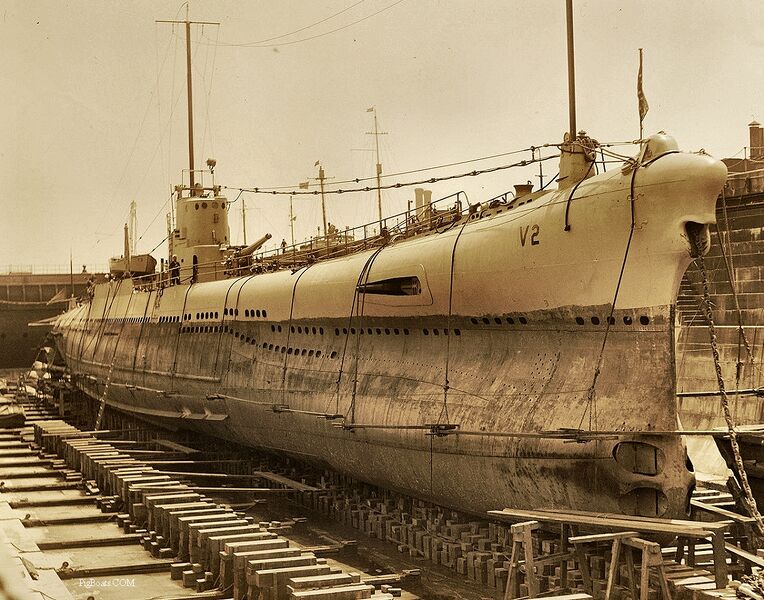V-2: Difference between revisions
Pbcjohnston (talk | contribs) mNo edit summary |
Pbcjohnston (talk | contribs) Added more photos |
||
| Line 9: | Line 9: | ||
[[File:Bass boston 1927-10.jpg|left|500px]] | [[File:Bass boston 1927-10.jpg|left|500px]] | ||
<div style="text-align: justify;"><span style="color:#00008B">In this view from the starboard bow, the draining process is proceeding, with keel blocks now visible. | <div style="text-align: justify;"><span style="color:#00008B">In this view from the starboard bow, the draining process is proceeding, with keel blocks now visible. Both of the V-2's small boats have been hauled out of their enclosures and placed on deck, likely for maintenance. These two views give a good view of the boat's unusual hull form. | ||
<small>Photo courtesy of the Boston Public Library, Leslie Jones Collection. Used with permission.</small> | <small>Photo courtesy of the Boston Public Library, Leslie Jones Collection. Used with permission.</small> | ||
| Line 26: | Line 26: | ||
<small>Photo by David Johnston</small> | <small>Photo by David Johnston</small> | ||
[[File:Red bar sub new.jpg]] | |||
<center> | |||
<gallery mode="packed" widths="350px" heights="250px"> | |||
File:Bass boston 1927-1.jpg | |||
File:Bass boston 1927-4.jpg | |||
File:Bass boston 1927-5.jpg | |||
File:Bass boston 1927-6.jpg | |||
File:Bass boston 1927-7.jpg | |||
</gallery> | |||
</center> | |||
<div style="text-align: justify;"><span style="color:#00008B">Five additional views of V-2 in drydock at Boston, fall of 1927. Platforms and ladders have been erected under her stern, likely to facilitate work on her aft torpedo tube muzzle doors, which are open in these shots. Above the tubes on either side of the hull are the angular propeller guards. On top of the hull, just forward of the flag staff is a cone shaped fairing for one of the boat's three radio antenna masts. The concept of operations for the fleet submarine called for very long-range radio communications. To achieve this, the V-2 and her sisters were equipped with two different sets of radio aerial wires. One set (probably for short range comms) had two heavy thick wires running from the stern fairing, up to a support stanchion on either side of the periscope shears, and down to a similar fairing on the bow. A second set of wires was attached to a mast that retracted into this fairing. These wires then ran to a heavy retractable mast aft of the periscope shears on the conning tower fairwater, then down to another retractable mast on the fairing at the bow. The bow mast (as seen in photos below) retracted down into the fairing and a tube that penetrated the bow buoyancy tank and then ran down between the torpedo tubes. The aft mast retracted down into the steering gear room above the rudder. | |||
Also very prominent in these photos are the V-2's small boats, used as liberty launches when the boat was anchored out. These boats were housed in deck fairings aft of the conning tower fairwater and were covered over with teak deck slats. To launch the boats the decking above them would be removed and the boats hoisted out of the fairings using a large kingpost/boom crane, each located just forward of the fairings. | |||
In the first and second photos the undulating sheer of her main deck can be clearly seen. | |||
<small>Photo courtesy of the Boston Public Library, Leslie Jones Collection. Used with permission.</small> | |||
[[File:Red bar sub new.jpg]] | |||
<center> | |||
<gallery mode="packed" widths="500px" heights="400px"> | |||
File:Bass boston 1927-9.jpg | |||
File:Bass boston 1927-11.jpg | |||
</gallery> | |||
</center> | |||
<div style="text-align: justify;"><span style="color:#00008B">In these bow photos two distinctive features of the V-2 stand out. The first is the bulbous bow, shaped somewhat like the nose of a porpoise or shark. This unusual design was intended to provide additional buoyancy and keep the bow above the waves at high speed. Unfortunately it was poorly conceived and it actually caused the bow to burrow into the waves, making for a very wet deck. The bow tapers to a very narrow width below the tank then flairs out again into a circular cross section in order to accommodate the bow torpedo tubes. When viewed from straight ahead, the bow looks a lot like a figure 8. The anchor can also be seen, and it is housed in a hawespipe inside the bow buoyancy tank. It gives the distinct impression of being held in the mouth of a shark. The windlass and pulley used to haul in the anchor was housed in a small bump fairing on the main deck just forward of the radio mast fairing. | |||
The holes along the side of the boat are "limber holes", used to flood the free flooding superstructure when the boat dives, and drain it upon surfacing. The large slit in the bow houses the retracted starboard side bow diving plane. | |||
<small>Photo courtesy of the Boston Public Library, Leslie Jones Collection. Used with permission.</small> | |||
[[File:Red bar sub new.jpg]] | |||
[[File:Bass surfacing.jpg|left|500px]] | |||
<div style="text-align: justify;"><span style="color:#00008B">V-2 surfacing. The date on the photo is February 12, 1928. This date makes the exact location uncertain as to the physical location the V-2 would be. According to DANFS she could have been in Pacific waters off San Diego, or the Hawaiian Islands or even in the Caribbean during this time frame. | |||
There is nothing else in the photo because it had been physically cropped by the newspaper service that had used the photo. It had much paint and ink on it that had to be removed by webmaster Ric Hedman in order to display the original image as seen here. | |||
<small>Original photo in the private collection of Ric Hedman</small> | |||
[[File:Red bar sub new.jpg]] | |||
[[File:Bass awning.jpg|left|500px]] | |||
<div style="text-align: justify;"><span style="color:#00008B">V-2 crew relaxing under an awning. The location is possibly Panama though it may also be San Diego or Hawaii. There just isn't enough information other than the awning. The date is probably between 1925 and 1930. | |||
Some of the crew have brought up blankets and pillows to lay on the deck to relax upon. Interesting to note that the bow of the starboard launch is protruding through the decking over the small boat storage locker. The kingposts for launching and retrieving these boats are see at the outer edges of the awning. There is a portable shower rigged on the very back edge of the conning tower fairwater. The hose leading to it can be seen arcing to the right and toward the left. | |||
The bitts seen on either side of the deck in the foreground appear to be retracting. The assumption is based on the fact that each has a handle built into the recessed top of each bitt. It is assumed that turning this handle would unlock or unscrew the bitt from a locked position and allow it to be lowered into the deck. This seems strange to be a strangely contrived attempt at streamlining on a boat with so many other sources of drag topside. | |||
<small>Original photo in the private collection of Ric Hedman</small> | |||
[[File:Red bar sub new.jpg]] | [[File:Red bar sub new.jpg]] | ||
Revision as of 16:02, 3 July 2023
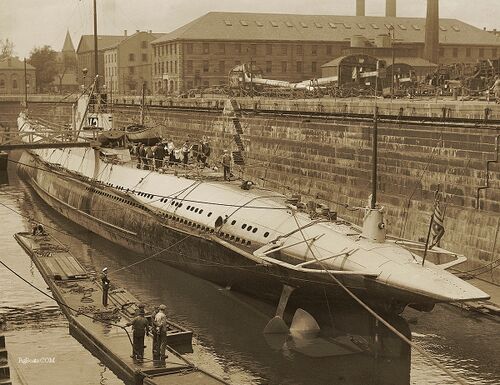
Photo courtesy of the Boston Public Library, Leslie Jones Collection. Used with permission.
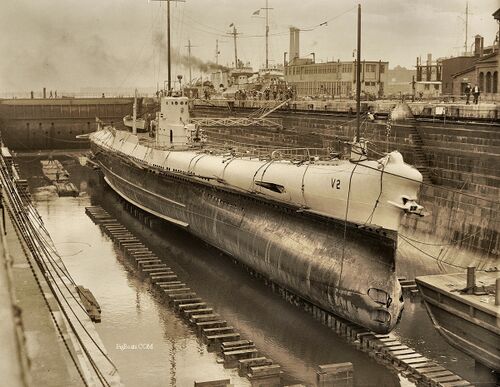
Photo courtesy of the Boston Public Library, Leslie Jones Collection. Used with permission.
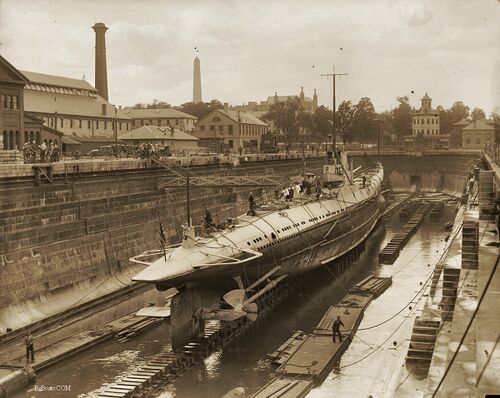
Photo courtesy of the Boston Public Library, Leslie Jones Collection. Used with permission.
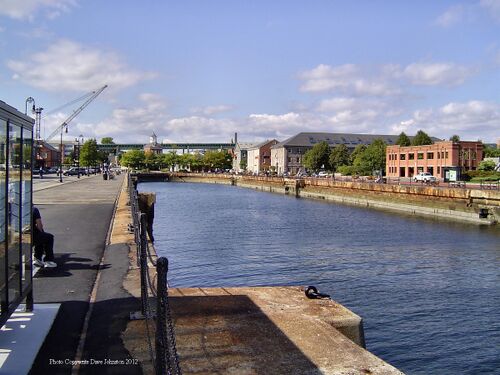
Photo by David Johnston
Also very prominent in these photos are the V-2's small boats, used as liberty launches when the boat was anchored out. These boats were housed in deck fairings aft of the conning tower fairwater and were covered over with teak deck slats. To launch the boats the decking above them would be removed and the boats hoisted out of the fairings using a large kingpost/boom crane, each located just forward of the fairings.
In the first and second photos the undulating sheer of her main deck can be clearly seen.
Photo courtesy of the Boston Public Library, Leslie Jones Collection. Used with permission.
The holes along the side of the boat are "limber holes", used to flood the free flooding superstructure when the boat dives, and drain it upon surfacing. The large slit in the bow houses the retracted starboard side bow diving plane.
Photo courtesy of the Boston Public Library, Leslie Jones Collection. Used with permission.
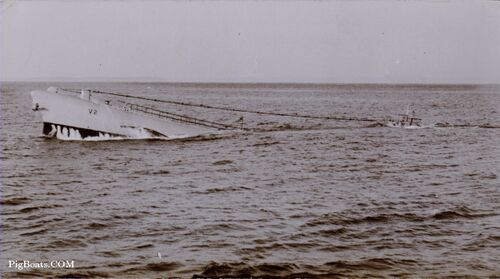
There is nothing else in the photo because it had been physically cropped by the newspaper service that had used the photo. It had much paint and ink on it that had to be removed by webmaster Ric Hedman in order to display the original image as seen here.
Original photo in the private collection of Ric Hedman
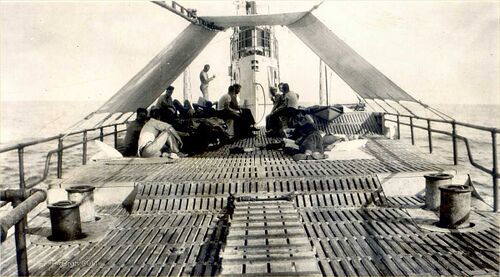
Some of the crew have brought up blankets and pillows to lay on the deck to relax upon. Interesting to note that the bow of the starboard launch is protruding through the decking over the small boat storage locker. The kingposts for launching and retrieving these boats are see at the outer edges of the awning. There is a portable shower rigged on the very back edge of the conning tower fairwater. The hose leading to it can be seen arcing to the right and toward the left.
The bitts seen on either side of the deck in the foreground appear to be retracting. The assumption is based on the fact that each has a handle built into the recessed top of each bitt. It is assumed that turning this handle would unlock or unscrew the bitt from a locked position and allow it to be lowered into the deck. This seems strange to be a strangely contrived attempt at streamlining on a boat with so many other sources of drag topside.
Original photo in the private collection of Ric Hedman
Page created by:
Ric Hedman & David Johnston
1999 - 2023 - PigBoats.COM©
Mountlake Terrace, WA, Norfolk, VA
webmaster at pigboats dot com





